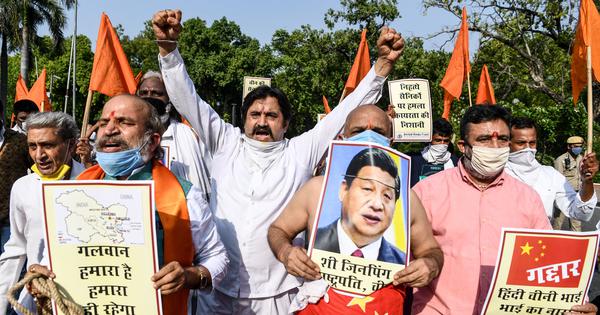
When China’s envoy in New Delhi, Xu Feihong, stood before the Indian media recently and condemned Washington’s new tariff regime on Indian exports, it felt like one of those moments in geopolitics where irony overshadows diplomacy.
A nation that only four years ago engaged in bloody clashes with Indian soldiers in Galwan now claims to stand shoulder-to-shoulder with New Delhi against American “Dadagiri”.
The word itself – half slang, half satire – was deliberately chosen, a jab at Washington’s perceived arrogance in global trade and politics.
Yet, beneath the rhetoric lurks a deeper puzzle: Is Beijing really reaching out to transform an old adversary into a partner, or is this simply another short-term move in the grand chess game of Asia?
For India, a country that still counts its fallen along the Line of Actual Control, the question is not rhetorical. Trust is expensive, and with China, the cost has always been unbearably high.
The choreography of recent weeks gives the impression of a thaw. Wang Yi’s visit to India, followed by speculation over Prime Minister Narendra Modi’s trip to Beijing for the Shanghai Cooperation Organization summit, has rekindled talk of a possible reset.
Commentators indulge in the fantasy of two Asian giants – home to nearly 2.8 billion people and vast reservoirs of talent, resources, and markets – setting aside their disputes to shape the future of the 21st century.
But history interrupts the fantasy. The humiliation of 1962, the tense standoff at Doklam, and the violence of Galwan remain unhealed wounds. Nations, unlike individuals, do not easily forgive.
They internalise memory into their strategic culture, carrying scars as part of their national DNA. India remembers Chinese aggression not as an isolated episode but as a recurring pattern. To believe that a few statements about tariffs can erase decades of suspicion is to mistake theatre for substance.
Still, one cannot dismiss China’s sudden empathy as random. The timing speaks volumes. Donald Trump, in his second presidential term, has revived his favourite economic weapon: tariffs. Indian goods are once again facing punishing duties, while threats of additional restrictions loom large.
This has caused genuine concern in New Delhi, where policymakers hoped for smoother trade relations with Washington after years of careful alignment.
For Beijing, the opportunity is golden. By siding with India against American tariffs, China paints itself as a champion of fair trade, subtly positioning itself as the alternative partner India might lean on. The implicit message is unmistakable: “If Washington mistreats you, remember we are here.” It is the classic “enemy of my enemy” strategy, familiar to students of diplomacy and perhaps best summarised in the aphorism: alliances built on resentment are as fleeting as resentment itself.
Of course, Chinese reassurances are contradicted daily by its own conduct. Maps are redrawn to claim Indian territory, villages in Arunachal Pradesh are renamed and dams rise on rivers flowing into India.
Beyond South Asia, Beijing projects power in the South China Sea with little regard for international law. The same government that lectures about “bullying” continues to bully its neighbours. For New Delhi, such duplicity is hardly a surprise. It reinforces a simple truth: China is less a friend in waiting than a rival seeking leverage.
Why India cannot ignore China
Yet India cannot afford to ignore the pragmatic layers of its relationship with China. Trade between the two nations reached $127.7 billion in 2024-’25, a figure that defies the language of enmity.
Indian pharmaceutical firms depend on Chinese raw materials; China supplies rare earths and machinery essential for Indian manufacturing. For its part, Beijing covets India’s vast consumer base.
Moreover, in forums like Brazil, India, China and South Africa grouping of BRICS and the G20, India and China often present a joint voice on behalf of the Global South, arguing against Western dominance of international institutions.
On issues such as climate finance or reform of global governance, their positions converge. These intersections reveal a paradox: Rivalry coexists with reluctant cooperation, suspicion with necessity.
Cooperation does not equal friendship. Genuine friendship in international politics is built on trust, and trust is precisely what has been shattered. The events of June 2020, when 20 Indian soldiers were killed in Galwan, serve as a permanent reminder of the fragility of the relationship.
Until the Line of Actual Control is demarcated and respected, no number of summits or declarations will change the underlying reality. Geography, more than rhetoric, dictates the future of this relationship.
Some analysts argue that Trump’s tariffs might catalyse a shift, nudging India and China closer. But this is to exaggerate the power of external shocks. India may be angered by Washington’s trade policies, yet it does not erase decades of mistrust with Beijing. Nor does it alter the centrality of Pakistan in India’s threat perception.
China’s continued investment in the China-Pakistan Economic Corridor, its indulgence of Islamabad’s position on Kashmir, and its diplomacy in Afghanistan only deepen Indian suspicions. Friendship cannot be forged while China sustains India’s most persistent adversary.
How does India see itself?
Equally important is how India sees itself. Unlike smaller states that often bind themselves tightly to a single patron, India has cultivated a policy of multi-alignment. It is part of BRICS, engages the SCO, remains a central member of the Quad, and maintains historical ties with Russia.
Rather than exclusivity, India prizes flexibility. To critics, this risks incoherence. To Indian policymakers, it is autonomy.
This strategic independence means that India will not be easily seduced by temporary alignments. If China imagines that a few gestures of sympathy can draw India into its orbit, it misunderstands the philosophical depth of New Delhi’s foreign policy.
Nevertheless, the idea of an “Asian century” led jointly by India and China carries an undeniable appeal. Together, the two nations could wield unprecedented influence over trade, technology, and climate negotiations. The slogan of “Asia for Asians,” once floated by Chinese strategists, would acquire legitimacy if India joined the chorus.
Dreams often collide with reality. For India, sovereignty and territorial integrity are not bargaining chips. As long as China refuses to respect those principles, the mirage of Asian solidarity will remain just that – a mirage.
A tilt toward China would also trigger ripple effects beyond the bilateral. The Quad – comprising India, Japan, Australia, and the United States – anchors New Delhi’s Indo-Pacific strategy. Were India to move closer to Beijing, even temporarily, questions would arise about its commitment to this grouping.
Would New Delhi risk alienating Tokyo, one of its most dependable partners, for the sake of a tactical alignment with China? Unlikely. Modi’s decision to visit Tokyo before his potential trip to Beijing is not accidental. It signals to both Washington and Beijing that India’s partnerships are broad and carefully balanced, not up for transactional exchange.
Thus, the most plausible future between India and China is not one of friendship but of managed rivalry. Open conflict serves neither side; both face domestic economic pressures and responsibilities on the global stage. Stability – fragile, conditional, and tactical – will remain the preferred option.
Stability should not be confused with trust. It resembles an armistice more than an alliance: Moments of cooperation in trade and climate negotiations, punctuated by sharp disputes over territory and Pakistan.
Ironically, the United States helps sustain this balance. Tariffs may irritate India, but Washington still offers partnerships in defence, technology, and education without the baggage of territorial disputes. Even an unpredictable America is preferable to a domineering China.
Beijing extends a hand of commerce while keeping the other on disputed maps. Washington, however imperfect, is not asking India to cede land. That distinction matters profoundly in New Delhi’s calculus.
Ultimately, the question of whether India and China can become true friends has only one sober answer: No.
They can trade, they can coordinate in multilateral forums, and they can avoid open conflict. However, friendship – rooted in trust, solidarity, and shared destiny – is a bridge too far.
Civilisational states with contested geographies and overlapping ambitions are bound less by affection than by balance.
And in that balance lies the thin line between rivalry and war, between uneasy peace and sudden escalation. The temptation of imagining strategic friendship may seduce some commentators, but India and China remain prisoners of their geography and history.
What they can realistically achieve is not intimacy but coexistence – a fragile coexistence that must be managed with caution, vigilance, and relentless realism.
HM Nazmul Alam is an academic, journalist, and political analyst based in Dhaka, Bangladesh. He can be reached at nazmulalam.rijohn@gmail.com.
This article was first published on Dhaka Tribune.
This article first appeared on Scroll.in
📰 Crime Today News is proudly sponsored by DRYFRUIT & CO – A Brand by eFabby Global LLC
Design & Developed by Yes Mom Hosting






